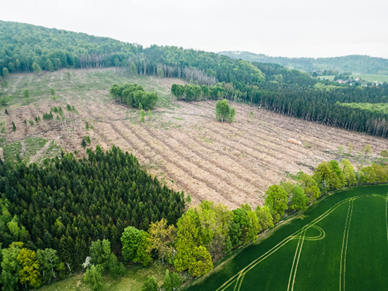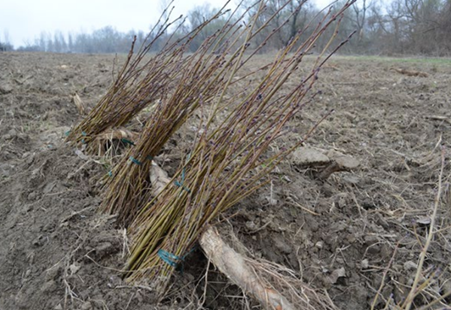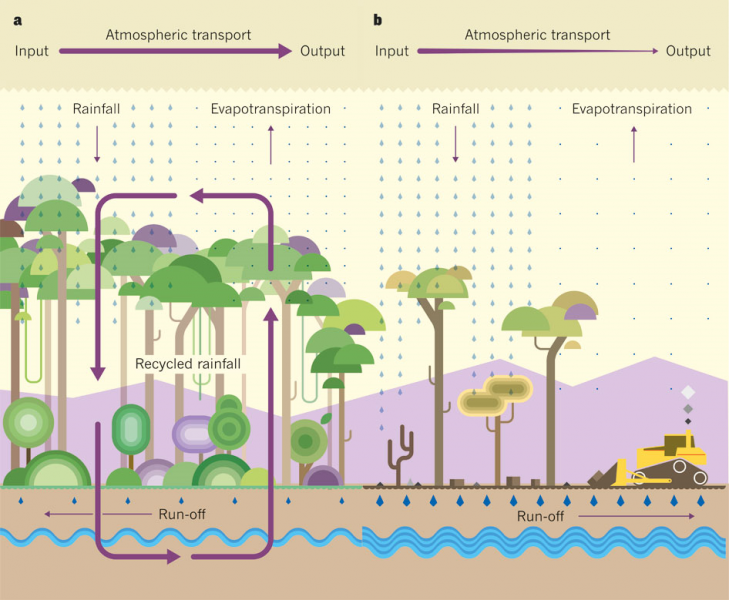- Reforestation
- Targeted planting for 'catching' precipitation
- Tree planting
- Establishing new trees
- Forestation
Forests act as natural sponges, absorbing excess rainwater to prevent flooding and retaining moisture for gradual release during dry periods. By increasing soil infiltration and storage, forests provide a consistent water supply, buffering against the extremes of climate change and increasing the resilience of ecosystems.
Afforestation / Reforestation
Afforestation refers to the establishment of a forest by planting or seeding on land previously used for other purposes. It involves the transformation of non-forested land into forested land. A wide set of land use changes exist which encompass the conversion of arable land to grassland, or the conversion of natural ecosystems such as tropical forests to areas of human use such as palm oil plantations, and afforestation is another one that is conversion of any type of land to forest. Key terms such as deforestation, rewilding, reforestation and afforestation are often used to describe these changes.

Illustration: reforestation (DE)
Source: GoForest project
In the case of afforestation, it can be deliberate or the result of marginal agricultural land being abandoned. The environmental benefits of afforestation depend on a number of factors, including the choice of tree species and the intensity of forest management. Planting native broadleaved species and applying low-intensity forestry practices tend to provide the greatest environmental benefits, such as increased evapotranspiration from growing forests and improved water-holding capacity of forest soils. However, plantation forestry with fast-growing conifers or exotic species (like eucalyptus) often provides fewer ecological benefits and has been linked to increased acidification and eutrophication. Instead, planting long-lived native broad-leaved trees is often recommended, as they increase biodiversity while minimising water loss.
Caution is needed in arid areas where afforestation may reduce local water availability by exacerbating water scarcity (see F04). Even though afforestation may reduce available water supply at local scale, forest cover increases water supply regionally and globally, in particular through the intensification of the water cycle.

Illustration: afforestation with typical local species (BU)
Source: WWF Bulgaria
Afforestation of reservoir catchments
Afforestation in reservoir catchments involves the planting of trees in areas that were previously bare or degraded. It can have a number of effects, both positive and negative. On the positive side, afforestation can control soil erosion, extend the life of reservoirs and improve water quality by allowing rainfall to infiltrate forest soils before reaching reservoirs. In addition, increased forest cover increases the capacity of the soil to store water.
However, these benefits must be weighed against the reduced availability of precipitation for reservoir recharge, as forests typically increase water loss through interception and evapotranspiration. Studies show that water yield tends to decrease as forests mature after afforestation.
Forests in reservoir catchments should generally not be managed for timber production, but maintained in as close to a natural state as possible as fertilisation and soil disturbance from intensive management practices can adversely affect water quality.

Illustration: afforestation (IR)
Source: catchments.ie
Targeted planting for 'catching' precipitation
There is some evidence to suggest that loss of tree cover on Mediterranean hill slopes has altered weather patterns, which in turn have altered precipitation amount and timing. Modelling results suggest that Mediterranean precipitation regimes are very sensitive to variations in air temperature and moisture. Land use change and associated deforestation may have led to changes from and open monsoon-type regime with frequent summer storms over inland mountains to a regime dominated by closed vertical atmospheric recirculation where feedback mechanisms suppress storms over the coastal mountains and lead to increased summer time sea surface warming. This warming leads to torrential rains in autumn and winter. These rains can occur across the Mediterranean basin. This can be exacerbated by greenhouse heating associated with air pollutants.
Carefully planned afforestation, particularly using local tree species, can help mitigate these problems by stabilising rainfall patterns and improving soil water retention. Care must be taken, however, as afforestation in dry, mountainous regions can reduce downstream water availability. Broadleaved forests, which use less water than coniferous forests, are often preferred to balance biodiversity and water conservation.

Functioning of the water cycle in forests
Source: Aragão, L. The rainforest's water pump